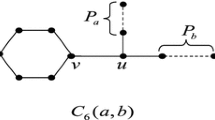Abstract.
Given a graph G, its energy E(G) is defined to be the sum of the absolute values of the eigenvalues of G. This quantity is used in chemistry to approximate the total π-electron energy of molecules and in particular, in case G is bipartite, alternant hydrocarbons. Here we show that if G is a bipartite graph with n vertices, then
must hold, characterize those bipartite graphs for which this bound is sharp, and provide an infinite family of maximal energy bipartite graphs.
Similar content being viewed by others
Author information
Authors and Affiliations
Additional information
Received: December 1, 2000 Final version received: August 28, 2001
RID="*"
ID="*" The author thanks the Swedish Natural Science Research Council (NFR) – grant M12342-300 – for its support.
Acknowledgments. The authors would like to thank Ivan Gutman for encouraging them to write this paper, and for helpful discussions on this topic. They also would like to thank Edwin van Dam for his reference concerning connected bipartite regular graphs with four eigenvalues.
Rights and permissions
About this article
Cite this article
Koolen, J., Moulton, V. Maximal Energy Bipartite Graphs. Graphs and Combinatorics 19, 131–135 (2003). https://doi.org/10.1007/s00373-002-0487-7
Issue Date:
DOI: https://doi.org/10.1007/s00373-002-0487-7




